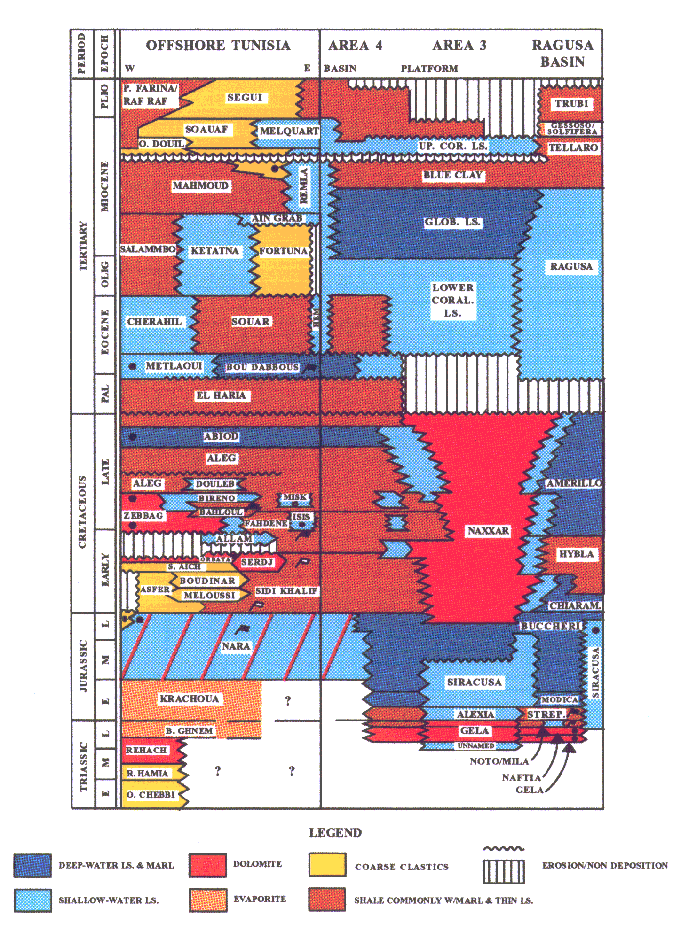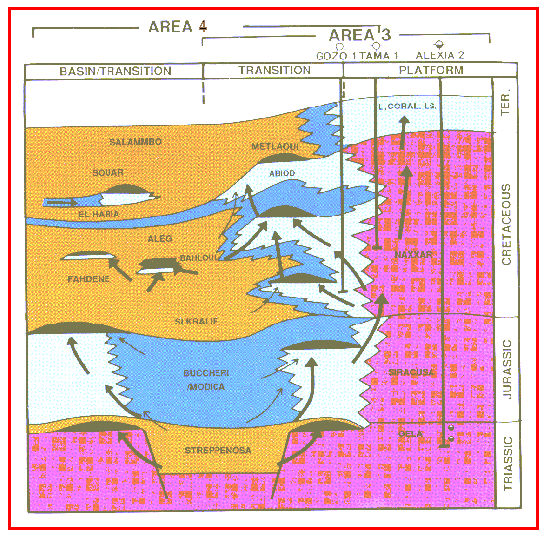
"Crude Petroleum" as it occurs in nature, is mainly a mixture of hydrocarbons belonging to the paraffin, benzene and naphthene series. Some varieties are viscous solids, some are liquid and others are gaseous. The great oil-fields of the world occur commonly in shallow water marine sediments. The exact nature of the original material which by slow distillation has given rise to the oil is a matter of dispute: land-plant residues, marine algae, phyto-plankton and remains of marine animals have been suggested. For the preservation of these, deficiency of oxygen at the site of deposition may be important. That which distinguishes petroleum from other sedimentary rocks is its powers of migration from the rocks in which it was formed to "reservoir rocks". these, by reason of their open texture afford storage room. Such rocks are sandstones and cellular limestones. Where these rocks are covered and sealed by relatively impervious beds such as shales, the petroleum may accumulate under great pressure due to the buoyant effect of ground water. When the covering rocks are pierced by the drill, the petroleum may rise to the surface. Channels of escape such as joints, faults, or the oil-bearing stratum itself at its outcrop, may be impregnated with solid bitumen representing the residue of the petroleum from which the lighter fractions have evaporated.
|
|
|
|
|
|---|---|---|---|
|
|
|
|
|
|
|
|
|
|
|
|
|
|
|
|
|
|
|
|
|
|
|
|
|
|
|
|
|
|
|
|
|
|
|
|
|
|
|
|
|
|
|
|
|
|
|
|
|
|
|
|
|
|
|
|
|
|
|
|
|
|
|
|
|
|
|
|
|
|
|
|
|
|
|
|
|
|
|
|
|
|
|
|
|
|
|
|
|
|
In the early 70's offshore licences were awarded to Shell, Aquitaine and Home Oil. Four dry wells were drilled between 1971 and 1973, AQ, HOM, MSA and MSB. The AQ and MSB had a Cretaceous objective whereas the other two had a Triassic one. Area No.1 was adequately explored, and the wells drilled there confirmed the presence of a carbonate sequence, but they did not reach the principle objective horizon productive in Sicily. It was recommended that when the technology of deep drilling improves, a well dug in Area No.1 deep enough to reach the Triassic strata may prove successful. In the first offshore area, the involved companies had drilled the following wells:
1...1971..Aquitane...shallow well...5875 ft....tertiary objective
2...1972..Home Oil...deep test......14452 ft...Triassic objective
3...1972..Shell Oil..deep well......16444 ft...Triassic objective
4...1973..Shell Oil..shallow well...2220 m.....tertiary objective
In 1974 the Medina Bank acreage was opened and Texaco were awarded four blocks, JOC three blocks and Aquitaine one. In 1980 Texaco spudded MB. Area No.2 is located between the first offshore exploration area and the Malta-Libya median line. The prospect covers the uplift which is an extension of the Tunisian shelf. The structure extends from Sfax to the east in the Medina Bank direction. The exploration of this area was received with a great deal of sensitivity from the Libyan quarters, and resulted in a number of political difficulties. but drilling was suspended because of a boundary dispute with Libya. This dispute was subsequently resolved at the ICJ in 1985.
In 1981 two awards were made in the north, one to IEOC and another one to Reading & Bates. By 1985 two wells were drilled, GOZ by Reading & Bates and ALX by IEOC. ALX tested good oil shows in the Triassic whereas GOZ was suspended in Cretaceous shales, short of the Triassic objective.
In 1990, two blocks in the north were awarded to Amoco-BHP and another two to Texaco. The former drilled VLT and encountered a dry Jurassic objective. In 1992 Amoco-Agip were awarded two blocks in the south. TAM was drilled in 1993 to a TD of 4064m in the Cretaceous after penetrating a dry Metlaoui objective. In 1993 Shell-Nimir were awarded Block 7 in the south. A 3-D survey was conducted but no wells were drilled. In 1997 an agreement was signed with AGIP for the exploration of an area to the north and another agreement was signed with ROC in 1998 for the exploration of Block 7 of Area 4. A similar agreement was signed with Hardman Resources et al. in 1998 for the exploration of Blocks 4 and 5 of Area 3.
STRATIGRAPHY
Four distinct Upper Triassic-Jurassic paleaogeographic domains can be recognized in offshore Malta, a strongly subsiding one characterised by basinal facies of the Noto, Streppenosa, Modica, Buccheri, Chiaramonte, Hybla and Amerillo Formations, a stable one characterised by shallow open to restriced water facies of the Siracusa and Naxxar Formations, an intermadiate domain characterised by open marine facies of the Siracusa-Buccheri combination and an evaporitic domain of the Krachoua Formation.
Proven source rocks of Upper Triassic and Lower Jurassic Noto and Streppenosa Formations were deposited in the basins. These formations are known to source the oil in the Ragusa Basin which extends into Blocks 1, 2, 3, 4 and 5 of Area 3 in the north.
A similar situation is inferred in the south-eastern parts of Area 4 where Jurassic faulting is observed along a NNW-SSE trend cutting through Blocks 5 and 7. Facies differentiation culminated in the Late Cretaceous. Three similar domains developed in regions covered by Area 4 and to the west of it: a platform domain characterised by a monotonic sequence of dolomites and limestones of the Zebbag and Halk el Menzel Formations drilled in Tama-1, an intermediate domain with rudist buildups observed on the shelf edge of the Melita Rise drilled offshore Tunisia (Isis field), and a third domain characterised by Zebbag dolomites overlain by a thick sequence of organic rich shales and limestones of the Fahdene, Bahloul, Aleg el Haria and Bou Dabbous Formation.
Transitional Cretaceous facies are present in GOZ and AQ indicating the Malta Platform limit to be close to these wells. GOZ which was suspended in the Early Cretaceous encountered a thick section of Hybla shales overlain by chalks which are reminiscent of the Abiod Formation in Tunisia. These chalks have also been encountered in AQ. Beds of porous, intertidal dolomite and shelf-edge calcarenite, altering with impermeable marl, mudstone and shale, are inferred to occur in the Cretaceous transition zone, providing good reservoirs and seal potential. Rudist-reef reservoirs, present in offshore Tunisia may extend into parts of Area 4. Cretaceous source rocks, equivalent to the Bahloul and Fahdene are also inferred to be present in this zone.
A very striking fourth domain is recognised in the western half west of Area 4. Geological and geophysical data indicate that the tectono-sedimentary history of the area followed the same pattern observed in nearby basins with important local salt movements. One observes on seismic sections a central broad structural high with thinning of the overlying Late Cretaceous sedimentary sequence as well as a rim syncline also of Late Cretaceous age. Towards the end of the Cretaceous salt activity appears to have been damped and basin inversion occurred.
Palaeocene and Lower Eocene Metlaoui reservoirs of offshore Tunisia may also be present in Area 4 and to the west of it. A shelf-edge carbonate build-up recognized on seismic sections in west of Area 4 is interpreted in this sense. An equivalent of the Bou Dabbous Formation, source rock to nearby Ashtart and Bouri fields, should be present.
Post-Eocene age Lower Coralline Limestone, Globigerina Limestone, Blue Clay and Upper Coralline Limestone are widespread. They have been encountered in all wells including MB and TAM.
Mudstone and claystone with abundant planktonic foraminiferids of Pliocene-Quaternary age, encountered in AQ, are present in the troughs of the Sicily-Channel rift complex and other subsiding areas. The thickness of these sediments is controlled by post-Miocene rifting, about 340m at the downthrown AQ and one metre at the upthrown MB. As much as 2,000m are estimated to be present in the deep troughs.

Tectonic reconstruction shows Late Triassic-Early Jurassic pull-apart basis in parts of offshore Malta. Here, Triassic carbonates of the Gela Formation (Gela, Ragusa) are a potential play but may be too deep to be economical.
Jurassic carbonates of the Siracusa (Vega, Perla) and Nara Formations (El Biban) are expected on the flanks of the Ragusa Basin in Area 3 and the Melita-Medina Basin in Area 4.
Cretaceous shelf-basin transition zone stratigraphic plays in reefal facies of the Zebbag Formation (Isis, Miskar) are likely to be widespread in Area 4 and to the west of it.
Metlaoui nummulitic bank facies (Ashtart, Bouri) of Tertiary age are also likely to be present in Area 4 and to the west of it, therefore appearing in places to be conformable with Cretaceous plays, making multiple play objectives likely.
Plays associated with halokinesis are also evident in the west of Area 4.
